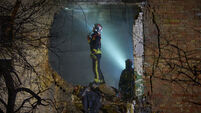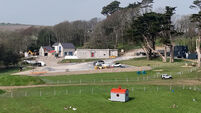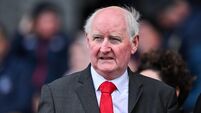In the shadow of St Peter’s
This is the pope who openly acknowledged that the papacy itself was the biggest obstacle to Christian unity — the promotion of which was a key objective of Vatican II (1962-65). Since then it has become increasingly evident that a monarchical papacy wedded to reactionary policies is the single biggest stumbling-block to internal reform.
Whoever emerges from the conclave in Rome will find that his pro or anti-reform stance will become the litmus test of his papacy. This is unavoidable given the state the Church is in following a series of devastating scandals.
And if there isn’t to be a continuation of the same repressive policies that have been characteristic of the Vatican since the election of Karol Wojtyla in 1978, then the Church is going to need a pope who is not just tolerant but appreciative of a “loyal opposition”.
Trying to impose a narrow orthodoxy, employing what I have called in the past a command-and-control modus operandi, has actually caused huge divisions in the Church, and the brutal stamping out of dissent has led to the unjust treatment of good and loyal priests seeking answers to questions on mandatory celibacy and the ordination of women that cannot be postponed indefinitely.
Fr Andrew Greeley, author of The Making of the Pope, is surely right when he wrote that the “most important decision the next pope must make is whether it is time for a change in the papacy’s style of governance”. Will that style continue to be monarchical, or will it be collegial? Will we get a pope who will listen, consult, and seek to truly be servus servorum Dei (“the servant of the servants of God”)?
Some years ago, an American bishop emphasised that “collegiality does not exist in its fullest sense if bishops are merely passive recipients of papal directives and initiatives”. One of his colleagues was even more direct when he emerged from a meeting with John Paul II: “He treats us like messenger boys”.
This is why reform of the papacy itself must be part of any wider Church reform. The Irish Augustinian theologian, Fr Gabriel Daly, has focused on the transformation of the papacy: “History has bestowed on the papacy an external magnificence which is difficult to reconcile with the ideals put before us by Jesus of Nazareth.”
When Paul VI met the then Archbishop of Canterbury, Dr Michael Ramsey, in the Vatican in Mar 1966, they agreed to establish a joint international theological commission which, in its final report, proposed a template for a reformed papacy.
The commission agreed that in a reunited Church the pope, as bishop of Rome, should have a universal primacy of honour as a sign and safeguard of unity, but not a primacy of authority. “The universal primate should exercise, and be seen to exercise, his ministry not in isolation but in collegial association with his brother bishops.”
Pointing out that “primacy is not an autocratic power over the Church”, the report was an expression of the concept of collegiality that was one of the key elements of Vatican II. Unfortunately Paul VI was succeeded by a pope (John Paul II) who turned out to be one of the most autocratic in the history of the modern papacy.
The central problem for Catholicism in the 21st century has been encapsulated by Diarmaid MacCulloch, author of A History of Christianity — where does ultimate authority lie, with “a papal monarch or with a collegiate decision by the bishops of the Church?”
The tragedy of Paul VI’s papacy is that he opened the way to collegiate decision-making by establishing the World Synod of Bishops, but then lost his nerve and decreed that it could not make binding decisions.
It was Paul VI of course who, in a single act, seriously undermined the moral authority of the papal office. He did this in Jul 1968 when he issued his anti-contraception encyclical, Humanae Vitae. And this despite the fact that the majority of the members of a special commission appointed by his predecessor had advocated lifting the ban on contraceptives.
Millions of Catholic couples across the world simply ignored the document. The reaction was not only personally very hurtful to Paul VI and very damaging to his papacy, it had a wider destabilising effect on the global Church.
The hope now must be that the next pope will see the need for a new sexual ethic, but will also consult widely and seek the collaboration of his brother bishops in formulating a new response to a range of moral issues, including contraception.
Of John Paul II and Benedict XVI, it could be said that their failure to consult and refusal to even attempt to govern collaboratively was a defining feature of their pontificates, largely because they were determined to rule as papal monarchs. As former president Mary McAleese has made clear in her recent book, Quo Vadis?, neither of Paul VI’s successors, John Paul II and Benedict XVI had any interest in implementing collegiality.
“In practical terms the Church’s day to day governance by the pope assisted by the curia remained untouched by Vatican II... The pope continues to exercise day-to-day control of the Church to the same extent as before Vatican II. No standing mechanism exists to facilitate the exercise by the College of Bishops of its power of governance.”
A standing mechanism did come into being with the establishment of the World Synod of Bishops. It was created, as Mrs McAleese has noted, to “meet a conciliar call for greater involvement by the episcopacy in universal church governance”.
But to do that in any meaningful way it would have to have a legislative function, something denied to it from the outset by the pope. Whatever chance it had under Paul VI disappeared with the arrival on the scene of John Paul II. He effectively emasculated the synod, and his successor, Benedict XVI, had no time for synodal decision-making. Both were quintessentially papal monarchs.
The nationality of the new pope will be far less important than his agenda. Whether the new pope is an Italian or a black pope or a pope from Latin America will count for little if the man who later this month steps onto the balcony of St Peter’s wearing the white vestments of the papacy opts for continuity.
To find a new way forward the pope must first look back. There is no paradox here — a blueprint for the future already exists, it only requires the new pope to remind the universal Church that the hallmark of his pontificate will be “Vatican II for slow learners”.
The speculation is inevitable but largely pointless. The names have been circulating since Benedict XVI’s abdication — Scola the Italian, Scherer from Brazil, Ouellet the Canadian, Turkson from Ghana, Schönborn from Austria — the truth is it is usually a guessing game.
It is salutary to remember that prior to the two conclaves in 1978, the two men who got elected (Albino Luciani as John Paul I and Karol Wojtyla as John Paul II) barely got a mention in all the pre-conclave speculation.
Whoever emerges onto the balcony overlooking St Peter’s Square faces a mammoth task.
“The Catholic Church today is polarised by deep disagreements between progressives and those who would restore the status quo ante the Vatican Council; between laity and lower clergy on the one hand and the Roman curia on the other; between those who favour the decentralisation suggested by the council’s theory of ‘collegiality’ and those who favour ever tighter control from Rome,” according to Fr Greeley.
Which side will the next pope be on? There remains for the new man the additional headache created by the manner of Benedict XVI’s resignation. This was highlighted at the weekend on BBC Radio 4 by Fr Thomas Reese, an American Jesuit in Rome to cover the conclave for the National Catholic Reporter. “The presence of two men in the Vatican called pope, both wearing white cassocks — this is very dangerous for the Catholic Church. I don’t think Benedict should be called Pope emeritus, I think he should be known as Joseph Ratzinger, Bishop of Rome emeritus, and should not wear white.”
What — if anything — will the new pope have to say about that?
















